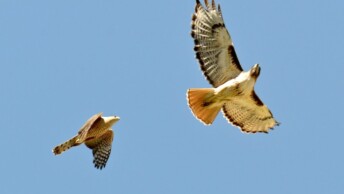North America’s crows and ravens belong to the genus Corvus, a group of highly intelligent and adaptable birds within the Corvidae family. Five species occur regularly in the United States and Canada, ranging from the widespread American crow and common raven to the more localized fish crow, Chihuahuan raven, and Tamaulipas crow. They can be challenging to tell apart, but differences in size, structure, vocalization, and habitat provide useful clues for identification.
American Crow
Corvus brachyrhynchos
- Identification: Medium-sized, all-black corvid with rounded tail.
- Where found: Widespread across the United States and southern Canada in open habitats, cities, farms, and coasts.
- How to spot: Look for noisy flocks, bold ground foraging, and familiar “caw” notes.
- Conservation status: Least Concern; stable overall, but vulnerable to West Nile virus and localized declines from hunting.
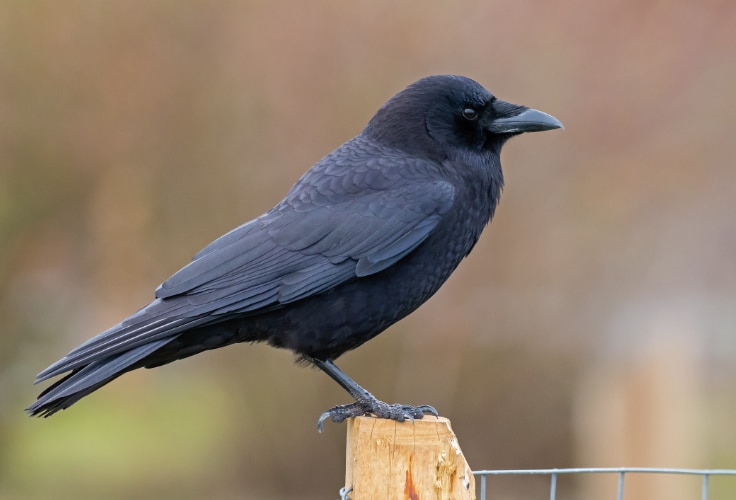
The American crow is the most widespread crow in North America, familiar in towns, fields, forests, and along coasts. It is a medium-sized corvid, measuring 40-53 centimeters (15.7-20.9 inches) in length. Its sturdy build, fan-shaped tail, and classic “caw” make it one of the most recognizable birds on the continent.
Adults are glossy black with violet or blue iridescence in good light. The stout bill and legs are black, and the eyes are dark brown. Both sexes look alike, though males average slightly larger. Juveniles appear duller and often show faded brownish wings and tail. Very young birds have gray-black plumage and pale bluish eyes before maturing into the adult look.
American Crows are most often noticed by their calls and behavior. They are highly vocal, with a wide range of “caw” notes, some used for long-distance communication and others for close contact. They move with steady, rowing wingbeats in flight and often gather in flocks to mob larger birds such as hawks or owls. On the ground, they walk boldly with a waddle, probing for insects, seeds, and scraps.
This crow inhabits nearly all of the United States and southern Canada, from Alaska to Newfoundland and south into northern Mexico. It avoids only the most arid deserts and dense unbroken forests. Resident across most of its range, some northern populations move slightly southward in winter. It nests in trees, often in woodlots, parks, or edges, and feeds on a wide variety of foods, including insects, seeds, carrion, and human refuse.
Abundant and adaptable, the American crow has generally thrived alongside people, though local declines have occurred. It suffered heavy persecution in the early 20th century, when mass shootings at roosts killed hundreds of thousands. The most serious modern threat has been West Nile virus, which can cause severe local die-offs. Nevertheless, the overall population remains large and stable, and this crow continues to be one of the most common and conspicuous birds in North America.
Common Raven
Corvus corax
- Identification: Very large, all-black corvid with massive bill, shaggy throat hackles, long wings, and wedge-shaped tail.
- Where found: Resident across most of Canada, Alaska, the western and northern United States, parts of the Appalachians, and into Mexico.
- How to spot: Look for solitary birds or pairs soaring with steady wingbeats, diamond-shaped tail, and deep croaking calls.
- Conservation status: Least Concern; populations increasing overall; occasional conflicts where ravens prey on vulnerable species.
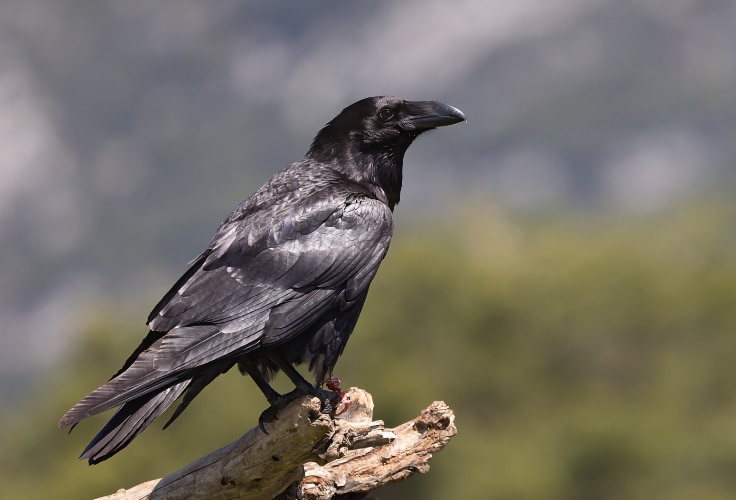
The common raven is the largest corvid in the world and an iconic bird of the Northern Hemisphere. It measures 56-69 centimeters (22-27.2 inches) in length, making it distinctly larger than any crow. Its massive bill, wedge-shaped tail, and shaggy throat feathers make it unmistakable when compared with crows and smaller ravens.
Adults are glossy black with an iridescent sheen, while juveniles appear duller with more brownish feathers that wear quickly before their second molt. Males and females are alike in plumage, though males are typically larger. When perched, the shaggy throat hackles are often fluffed, especially in displays.
Ravens are bold, playful, and intelligent, often performing aerial acrobatics such as rolls, dives, and even flying upside down. Their flight is more buoyant and graceful than that of crows, with steady wingbeats punctuated by gliding or soaring. They are also among the most vocal of birds, producing a wide variety of sounds beyond the classic deep croak, including knocks, clicks, and bell-like notes.
In North America, this species is found across Alaska, Canada, and much of the western United States, extending south into the mountains and deserts of Mexico. It also inhabits parts of the Appalachian and northeastern U.S., where it has been recolonizing after past declines. Common ravens occupy nearly every habitat from tundra and deserts to coasts, forests, and cliffs. They nest on cliffs, tall trees, and human structures, and feed opportunistically on carrion, insects, grains, eggs, and refuse, often caching food for later.
Common raven populations are stable or increasing, aided by their adaptability to human-altered environments such as landfills and roadways. Historically persecuted and extirpated from much of eastern North America, they have made a steady comeback with forest regrowth. Today, conflicts occur where ravens prey on threatened species such as seabirds or desert tortoises, and management efforts have attempted to limit this impact. Overall, however, the species remains widespread and secure, a thriving symbol of resilience and intelligence across its range.
Fish Crow
Corvus ossifragus
- Identification: Small, all-black crow with slightly rounded tail, glossy plumage, and distinctive nasal “uh-uh” call.
- Where found: Southeastern United States, most common along coasts, rivers, and wetlands; range expanding northward and inland.
- How to spot: Listen for nasal calls; look for smaller, shorter-legged crows often in flocks, frequently near water or urban areas.
- Conservation status: Least Concern; populations stable to increasing; vulnerable to West Nile virus but expanding range overall.
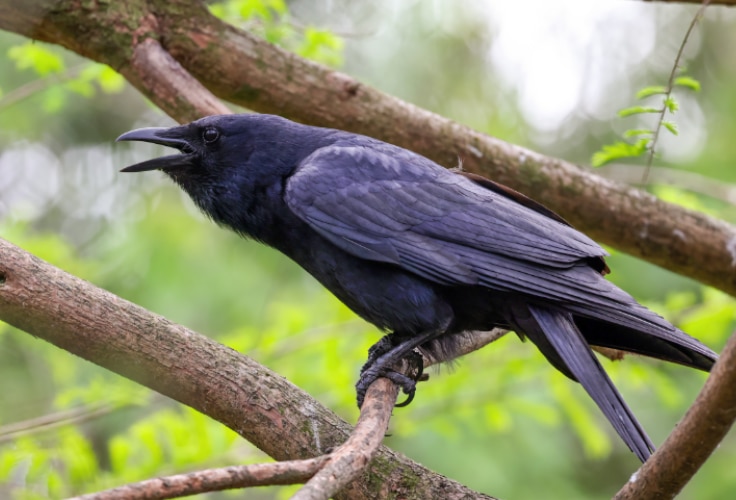
The fish crow is a smaller relative of the American crow, notable for its southeastern range and unmistakable nasal voice. Measuring 36-40 centimeters (14.2-15.7 inches) in length, it has a more delicate build with a slimmer bill, shorter legs, and quicker wingbeats. These structural differences are subtle in the field, making the call the most reliable way to tell the species apart.
Adults are glossy black with a violet or green sheen, while juveniles appear duller, with fluffier feathers and pale gray eyes. Sexes are alike in plumage, though males average slightly larger. Unlike American crows, which often show a longer-legged stance, fish crows appear more compact, especially when walking or perched.
The best clue to identifying a fish crow is its voice: a nasal, two-noted “uh-uh” or single sharp nasal “cah.” This separates it from the familiar “caw” of the American crow. Fish crows are also highly social, often gathering in large flocks, joining mobbing groups against hawks and owls, or feeding near gulls where they sometimes steal food. Playful behavior, such as hanging upside down or manipulating objects, has also been observed.
Fish crows are most abundant along the Atlantic and Gulf coasts, from Florida north to southern New England, and inland along major river valleys into the Mississippi basin. They are strongly associated with wetlands, estuaries, and waterways but also adapt to towns, agricultural areas, and suburban environments. Their diet is omnivorous, including carrion, invertebrates, seeds, and human refuse.
The species has generally increased in numbers since the mid-1900s, with expansion north into the Northeast and inland into river systems. Like other corvids, fish crows suffered from West Nile virus outbreaks in the early 2000s, but populations have since rebounded. They remain abundant in many areas and, unlike the American crow, are confined almost entirely to the United States. While sometimes hunted or considered pests, their adaptability ensures that they continue to thrive.
Chihuahuan Raven
Corvus cryptoleucus
- Identification: Medium-sized raven with glossy black plumage, blunt-tipped bill, wedge-shaped tail, and distinctive white-based neck feathers.
- Where found: Southwestern United States and northern to central Mexico, in open grasslands, deserts, and scrublands.
- How to spot: Look for pairs or flocks in arid plains, listen for higher-pitched calls than common raven, and watch for exposed white neck feathers in wind or display.
- Conservation status: Least Concern; stable overall, though localized declines in northern range due to habitat change.

The Chihuahuan raven is the characteristic raven of North America’s dry grasslands and deserts, often replacing the common raven in open lowland habitats. Measuring 46-53 centimeters (18.1-20.9 inches) in length, it is closer in size to the American crow than to its larger raven relative. Despite this smaller stature, it has the heavy bill, pointed wings, and wedge-shaped tail typical of ravens.
Adults are glossy black with a violet or bluish sheen, and their stout, blunt-tipped bill gives a “Roman nose” profile. A distinctive feature, though only visible when feathers are fluffed, is the white base of the neck feathers, unlike the gray bases of common ravens. Juveniles appear duller and lack the iridescent gloss. Males and females are similar in plumage, with males averaging slightly larger.
In the field, Chihuahuan ravens are best separated from common ravens by their smaller size, higher-pitched calls, and their preference for open country. Their voice is a harsh, crow-like “caw” or “quark,” often given in series. They walk with confidence on the ground, soar on thermals, and sometimes engage in flight displays such as barrel rolls. Social behavior is pronounced, with pairs joining neighbors to mob predators and flocks forming around food and water sources, especially outside the breeding season.
The species breeds across southeastern Arizona, New Mexico, western Texas, and into adjacent parts of southeastern Colorado, western Oklahoma, and southwestern Kansas, extending south through northern and central Mexico. It favors arid grasslands, mesquite scrub, and desert regions, often nesting in mesquite or acacia trees, utility poles, or windmills where trees are scarce. Their diet is omnivorous, including insects, small vertebrates, carrion, crops, and refuse.
Chihuahuan ravens remain locally common and adaptable, but some declines have been noted at the northern edges of their range where shortgrass prairie has diminished. Historically persecuted as crop pests, they also face modern hazards from electrocution on power poles and reduced nesting success linked to agricultural chemicals. Nonetheless, populations across the core range appear stable, and the species continues to thrive in much of its arid domain.
Tamaulipas Crow
Corvus imparatus
- Identification: Small glossy black crow with purplish upperparts, bluish underparts, and a blunt bill; frog-like croaking calls.
- Where found: Northeastern Mexico from Tamaulipas to northern Veracruz; rare visitor and occasional breeder in southern Texas.
- How to spot: Look for small flocks in towns, farmland, and dumps; listen for low, guttural croaks unlike other crows.
- Conservation status: Least Concern; suspected declines in Mexico; still locally common but much reduced in recent decades.
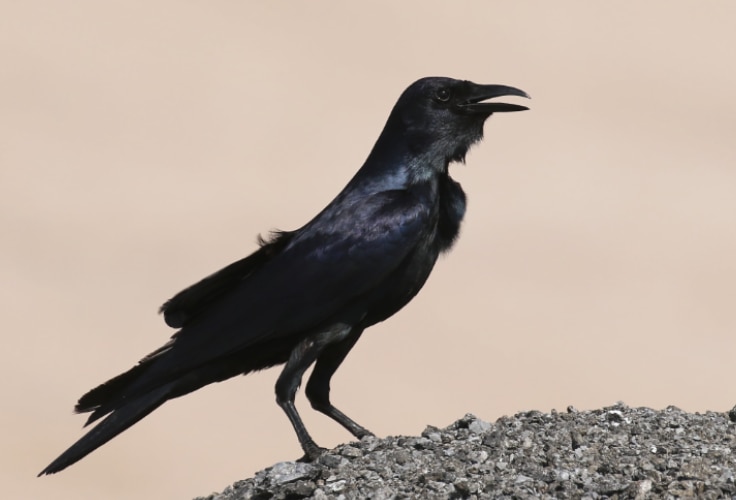
The Tamaulipas crow is the smallest crow species in North America, confined mostly to northeastern Mexico and rarely reaching the southern tip of Texas. Measuring 35-40 centimeters (13.8-15.7 inches) in length, it resembles a crow in miniature, but with a distinctive glossy sheen and unusual voice. It has attracted much interest among U.S. birders, especially when small flocks appear near Brownsville.
Adults are entirely glossy black with purple highlights on the crown, nape, and upperparts, and bluish to greenish gloss on the underparts. The wings and tail show steel-blue and violet reflections in good light. Juveniles are duller and sootier, with less sheen. Males and females are similar in appearance, with no marked sexual dimorphism.
The species is best recognized by its unusual vocalizations, described as low, frog-like croaks, grating “ahrr” calls, or doubled “rrah-rrahk” notes. These sounds are lower in volume and less resonant than the caws of American or fish crows, giving the bird a comical or subdued presence. Tamaulipas crows usually forage in flocks, walking on the ground or searching in trees, and often gather at roosts or around human settlements.
Its range covers the lowlands of northeastern Mexico, from Tamaulipas south to northern Veracruz, usually below 900 meters (3,000 feet) in elevation. In the United States, it occurs irregularly in the Brownsville area of southern Texas, where it has occasionally nested. The species inhabits semi-open scrub, farmlands, ranch lands, villages, and garbage dumps, showing a strong association with human-modified landscapes. Its diet is omnivorous but poorly studied, likely including insects, seeds, refuse, and carrion.
Although still locally common in parts of Mexico, surveys suggest Tamaulipas crow has declined sharply since the late 20th century. Reports indicate population reductions of more than 50% in recent decades. It is not formally protected in much of its range, and habitat change or persecution may contribute to its apparent decline. Despite this, the Tamaulipas crow endures as a distinctive and unusual corvid of the Mexican lowlands and an occasional rarity north of the border.
Final Notes on North America’s Crows and Ravens
Crows and ravens are among the most recognizable and intelligent birds in North America, thriving in habitats from forests and deserts to cities and farmland. Although telling them apart can be tricky, careful attention to size, shape, and voice makes identification possible. These five Corvus species highlight the adaptability and intelligence that have made crows and ravens successful across the globe.



